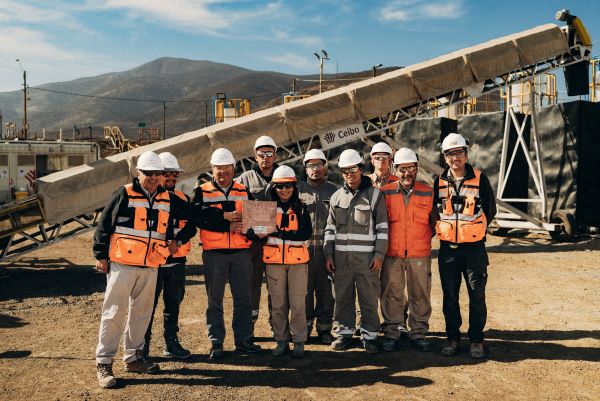
Sixty-five miles east of the sun-drenched city of Tucson, Arizona, lies the historic copper mine, Johnson Camp. Active on and off since the 1970s, the mine is being resurrected in response to a booming copper market.
As material is extracted at the mine, it will be separated into different piles; oxide copper in one pile and primary sulphide copper in another. The former will be sent to one portion of the heap leach pad for conventional oxide leaching using hydrometallurgy. The sulphides will leach using novel technology developed over three decades by Rio Tinto.

Discover B2B Marketing That Performs
Combine business intelligence and editorial excellence to reach engaged professionals across 36 leading media platforms.
Johnson Camp, now operated by Gunnison, will be the scene of the first industrial-scale trial to prove the technology’s efficacy – a major milestone since Rio Tinto launched a new venture called Nuton to develop it in 2021. After the technology is installed in August, first copper is expected by the end of 2025.
New approaches to old problems
Primary sulphide ore, typically dominated by copper deporting to the mineral chalcopyrite, is the most abundant type of copper ore in the world. It is typically crushed and milled producing a flotation concentrate. This flotation concentrate is then typically smelted using a heat intensive pyrometallurgical process, casting the copper into raw copper anodes, which are then electro-refined to produce a pure copper product.
Nuton’s process, however, uses a unique culture of microorganisms added to the ore. These bacteria multiply, harnessing energy from the oxidation of minerals in the rock to grow and simultaneously assist with leaching of the copper, achieving a recovery rate of up to 85%. Aeration and acidified water support the process with subsequent processing of the leach solutions producing 99% pure copper cathode.
Bioleaching is just one of several novel methods conceived to extract more copper from new and existing mines – including copper previously considered uneconomical because of low grades or small deposits – more sustainably and more quickly to meet the growing demand.

US Tariffs are shifting - will you react or anticipate?
Don’t let policy changes catch you off guard. Stay proactive with real-time data and expert analysis.
By GlobalDataThe International Energy Agency predicts a 30% shortfall in supplies of copper, a key component in electricity networks, by 2035 if nothing is done. This is against a wider expectation that to achieve net zero, copper demand will grow from 25 million tonnes (mt) in 2021 to 31.3mt by 2030.
At Johnson Camp, the plan is to optimise Nuton’s technology so it can be adopted at a commercial scale across a portfolio of around ten partnerships Nuton has been brokering.
“It feels like a special moment,” says CEO Adam Burley, who has worked at Rio Tinto for more than 20 years. “With data, analytics and AI there is an enormous ability to rapidly evaluate the performance of the technology and run different scenarios around the operating conditions and how we apply and adjust it – we couldn’t have done that 30 years ago.”
Perhaps most notably, the technology does not require a concentrator in the processing of primary sulphides, potentially making it much cheaper and requiring a much smaller footprint.
“Concentrators can be difficult to permit, they are more water intensive and produce a concentrate that needs to be exported for smelting and refining into a finished product,” explains Burley. “Nuton offers an economic, high-recovery solution, potentially comparable to a concentrator, but with less land use and water consumption to produce a finished copper cathode which can be, in part, consumed domestically.” This is a prospect that can reduce an over-reliance on China, which produces 40% of copper.
The current expectation is that the overall capital expenditure and operating expenses of bioleaching will also be less, with the copper recovery from primary sulphides expected to be higher (although this may vary). One drawback of this kind of technology, however, is that if the base carries commercial levels of by-product, such as gold, the process cannot currently recover both.
Other movers and shakers in copper
Meanwhile, BHP Billiton has invested in Chilean start-up Ceibo, a company that started as a dust mitigator business but moved into copper extraction after spotting an opportunity. Rather than using bio-leaching processes – which it considers not as “controllable” – Ceibo has developed electrochemical reactions that catalyse the oxidation in primary sulphide ores. This is a faster and cleaner process for extracting copper sulphides, according to the company.
In early June, Ceibo announced delivery of its first copper cathodes from a demonstration plant at a mine site in northern Chile owned by Cia. Minera San Geronimo. Marketing consultant Radhika Iyer says the technology can be used with low ore grades and chalcopyrite.
“Ceibo’s process can extend the life of a mine, is less capital intensive, has a smaller footprint and reduced cost compared to building a concentrator and refining,” Iyer explains.
The technology is currently being scaled, including in collaboration with Glencore, and has been tested on 50 different ores.

In the US, Endolith, headed by Liz Dennett, is, like Nuton, developing technology that uses microbes – the “Earth’s oldest miners”, as she puts it – to produce copper.
Dennett has a PhD in astrobiology and worked for NASA looking at how microbial life can oxidise and reduce iron and sulphur – the core of what happens in heap leaches, she says.
In May, Endolith reached a milestone when it demonstrated a significant uplift in copper recovery from low-grade sulphide ores during testing in simulated field conditions. The tests used samples provided by BHP.
Dennett, who previously worked as a lead architect at AWS building cloud native platforms, as well as a vice-president at Wood McKenzie, says the technology uses “logical intelligence”.
“We are evaluating microbial communities with real-time diagnostics to get the most from low-grade ores such as chalcopyrite and mixed sulphides that are increasingly challenging to extract,” explains Dennett.
The microbes are housed in a shipping container and can be plugged into existing systems. Endolith, which is working with six copper producers, is preparing to launch its first field deployments.
Opportunity awaits
There are several other companies working on scaling similar nascent technologies, including Destiny Copper, Still Bright, Jetti Resources and Kofiln, which speaks to the big opportunity the market has identified.
Jack Kennedy, a climate and mining investor at Founders Factory – a partner in Rio Tinto’s Accelerator Programme, as well as an investor in Endolith – says mining is a $2trn industry with so little investment to date that the potential of these technologies is significant.
“Each one can potentially crossover in the future and work together, which would be very interesting for us to see. It is a big, big market,” he says.
If successfully proven at scale, these technologies could be in widespread use by the end of the decade. There have been setbacks, however: Freeport-McMoRan, an early investor in Jetti, partnered with the start-up at its El Abra mine in Chile, but is no longer using the company’s technology, instead pursuing its own.
One of the biggest challenges start-ups face is winning mining companies’ trust, says Dennett.
“Another is these heaps are very dynamic, ore grades have fallen from around 3% a century ago to 0.7% now; we need to ensure our technology can address high impurity ores using higher concentrations of salt water or brackish water, that these microbes can thrive in any conditions,’ she says.
Nevertheless, Dennett is bullish, not just Endolith’s potential but also her competitors’.
“This truly is ‘a rising tide lifts all ships’, because if you consider the amount of copper we need by 2050 all of these technologies will be needed; if we can go to mines already in production and extract 90% or more copper it will minimise mining’s footprint,” Dennett adds.
Maximising recovery from existing copper mines
Wheaton Precious Metals president and CEO Randy Smallwood says trying to increase what can be extracted from an existing mine “makes all the sense in the world”.
“The industry should focus on measures including technology and efficiency that can maximise what is extracted from existing mines as well as lowering [environmental] impact where possible,” he says. “Some of that comes from technology and some from regulatory frameworks [allowing mine expansion].”
This is part of the ethos behind Wheaton’s $1m Future of Mining Challenge award for innovation, he says.
“What it all comes down to is more product with less impact, trying to minimise either the carbon loading or improving or increasing the amount of copper recovered,” he says.
Eric Saderholm, managing director of exploration, American Pacific Mining, who has worked in the copper industry for four decades, agrees these technologies “check most of the boxes”.
“The world [currently] produces approximately 25mt of copper per year and that’s not sustainable [to meet demand if you are] only using traditional smelting and higher-grade ores going through smelters,” he says. “Bioleaching will fill a necessary gap in global demand. In particular, it is going to open up doors for smaller deposits worldwide that can be exploited relatively quickly.”





